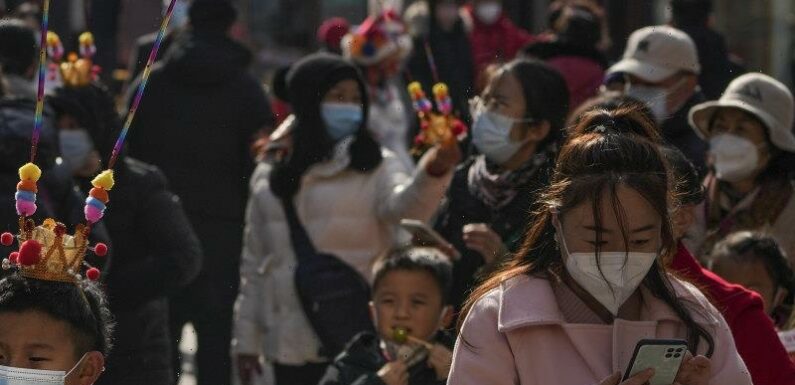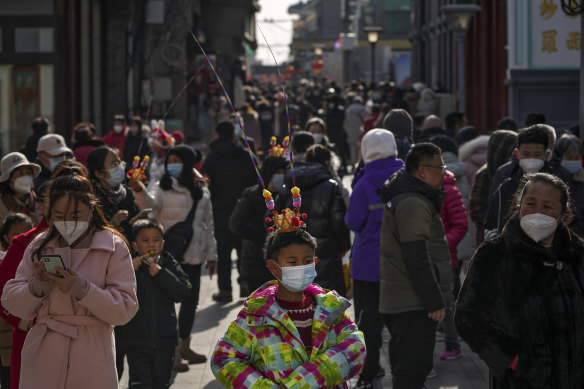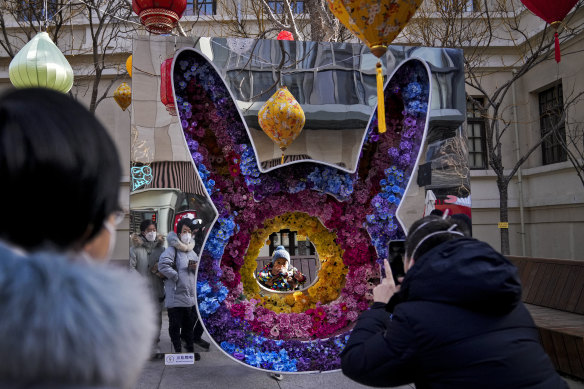
China said its COVID-related death toll topped more than 12,600 in the week before the Lunar New Year holiday, while a top health official suggested more than 1.1 billion people had been infected since virus controls were abruptly dismantled late last year.
There were 12,658 Covid-linked deaths at hospitals between January 13-19, the Chinese Centre for Disease Control and Prevention said in a statement dated Saturday. A week earlier, the country reported 59,938 such deaths for the period December 8-January 12.
A child wearing a face mask dressed tours a pedestrian shopping street at Qianmen crowded with visitors on the first day of the Lunar New Year holiday in BeijingCredit:AP
The data comes after China came under fire for dramatically narrowing its definition of a COVID-19 death and halting daily caseload reports. The World Health Organisation has urged Beijing to release more detailed information on the country’s COVID situation as the virus spreads rapidly throughout China after the sudden lifting of extensive COVID Zero restrictions.
China now appears to be trying to appease those concerns by reporting on deaths that fall outside the narrowed definition, which only counts fatalities from infected people with respiratory failure. Even so, the numbers China is now revealing still present just a partial picture given they count only deaths at hospitals, ignoring those that occur at home and in aged-care facilities. The true toll could be hundreds of thousands higher given the extent of the outbreak and compared with mortality rates in other countries.
Separately, the China CDC’s chief epidemiologist, Wu Zunyou, said in a Weibo post at the weekend that 80 per cent of the population has been infected in the current outbreak. China had a population of 1.41 billion at the end of 2022, suggesting more than 1.1 billion people have contracted the virus so far.
Wu didn’t elaborate on how the figure was calculated, given the country’s vast testing apparatus has been dismantled.
Women wearing face masks watch a toddler pose for a souvenir photo with a rabbit shaped floral decoration during the Lunar New Year holiday in Beijing.Credit:AP
While travel during the Lunar New Year holiday period, currently underway, may lead to an uptick in cases in some regions, Wu said there is “very little chance” for large-scale infections or a second nationwide outbreak in the next two to three months.
Chinese officials have been eagerly pushing the view that the current COVID-19 outbreak has peaked as they look to encourage a fast economic rebound after about three years of crippling restrictions and lockdowns. The economy grew just 3 per cent last year, the second-slowest pace since the 1970s.
Vice Premier Liu He last week told the World Economic Forum’s annual meeting in Davos, Switzerland, that growth will rebound to pre-pandemic levels after infections passed their peak. Outgoing Vice Premier Sun Chunlan, who once was synonymous with the country’s hardline pandemic approach, last week said infections have fallen to a “relatively low” level.
Concern over rural spread
Still, there are signs the ruling Communist Party are concerned about the virus spreading into parts of the country less resourced than the major cities when it comes to hospitals and medical supplies.
President Xi Jinping singled out COVID’s rural spread in a nationwide video address before the New Year holiday, saying he’s especially concerned about efforts to battle the virus in the countryside. Experts are worried Covid could ravage vulnerable people in villages that have sparse healthcare infrastructure, with the reopening wave already leading to overwhelmed hospitals and crematoriums in the major cities.
There are only 1.62 doctors and nurses combined for every 1,000 people in rural China, compared to rates of 2.9 and 3.3 nationally. Access to intensive care with experienced doctors and equipment like ventilators to help gravely ill patients survive is often miles away.
Expectations the holiday — which typically falls in winter and sees millions of people travel home to their villages and towns — will supercharge spread saw predicative health analytics firm Airfinity Ltd. raised its estimate for Chinese Covid deaths to 36,000 a day, an increase of 11,000 every 24 hours from a previous forecast, after taking into account travel during holiday.
Bloomberg
Get a note directly from our foreign correspondents on what’s making headlines around the world. Sign up for the weekly What in the World newsletter here.
Most Viewed in World
From our partners
Source: Read Full Article

